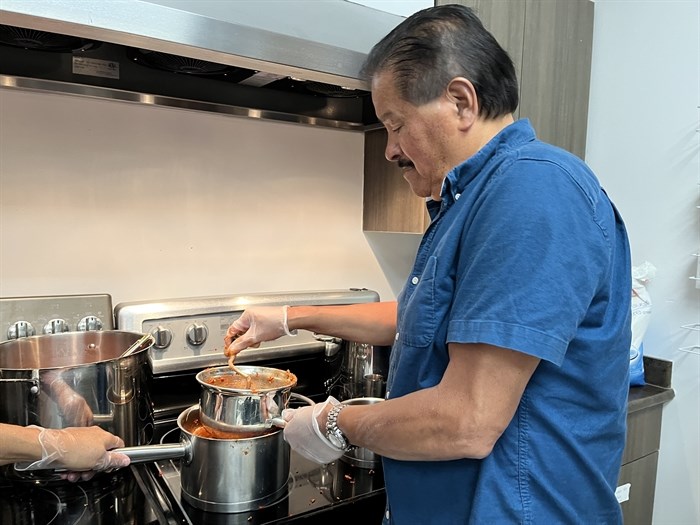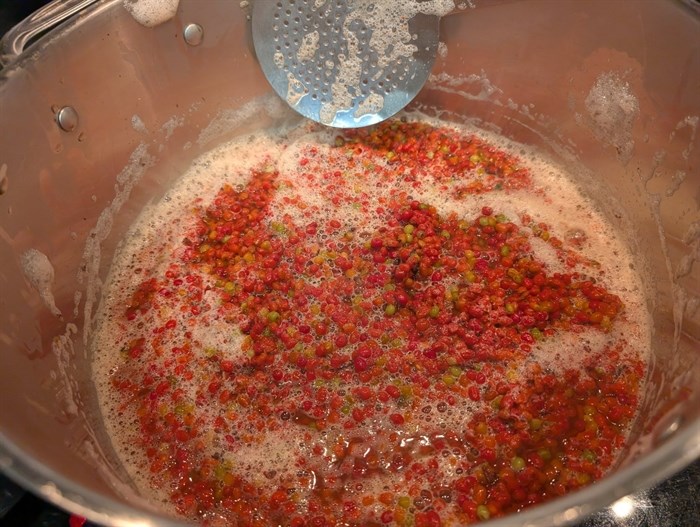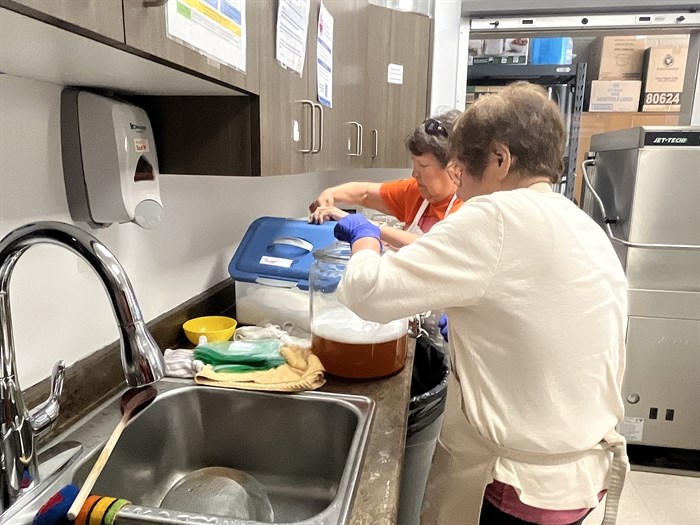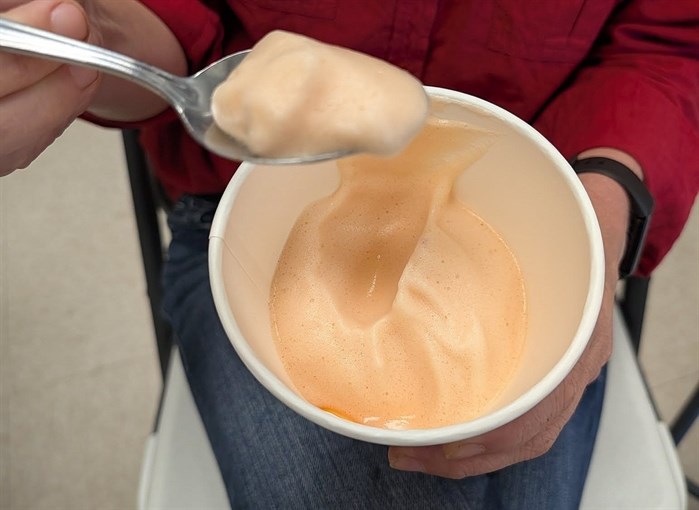
Member of the Kamloops Aboriginal Friendship Society Herb Charlie renders soapberries over a stove.
(SHANNON AINSLIE / iNFOnews.ca)
July 19, 2025 - 5:00 AM
Laughter and joyful conversations filled a small, warm kitchen in Kamloops earlier this week, as Indigenous Elders canned bright red soapberries, turning some of them into traditional Indian ice cream.
The members of the Kamloops Aboriginal Friendship Society are like a big family of seniors who gather to share traditional Indigenous knowledge and recipes, harvest seasonal plants off the land, make crafts and take care of one another.
Just like a family, there is a lot of joking among the group and dividing of tasks.
Some members were gathered around a table in a rec room chatting and making jewelry when iNFOnews.ca stopped by on July 15, while others were working together in the kitchen rendering soapberry juice for canning, a seasonal practise they do at this time every year.
“We picked the berries a few days ago, and I’ve removed all the stems and leaves out of them to get them ready,” said Elder’s Coordinator Dee-Anna Charlie.
The soapberries are boiled, churned and pressed to remove the seeds and skins, and the orangey-pink juice is poured into jars that will keep for a year for later use. Some of it is turned into juice and ice cream to enjoy right away.
Knowledge keepers Cynthia Ward and Dolly LeBourdais oversee the production from a couple of chairs. They’ve been harvesting and canning the berries since they were kids.
“I grew up with it, you can’t go without it,” Ward said. “It’s embedded into you and you teach it to your kids, too.”

These soapberries are being rendered for canning, juice and Indian ice cream at Kamloops Aboriginal Friendship Society.
Image Credit: SUBMITTED/ Dee-Anna Charles
LeBourdais has spent many seasons out foraging for soapberries and said sometimes late spring frosts will kill the berries but most years they are abundant. The berries are ripe when they turn from green to red colour.
“You can pick it green too, it’s just harder to come off,” Ward said. “If it’s really ripe, you just bump the branch and it all falls off.”
After the stems are removed and the berries are rinsed, they are put in a pot and boiled until they are soft, then strained and crushed. When the Elders were young, they did this part by hand using cheesecloth or flour sacks.
“Mom used to save a few of those flour sacks and wash and clean them, and we’d use that to squeeze the juice out,” LeBourdais said.
The women go to a counter where LeBourdais adds water and sugar to some of the rendered juice to make a refreshing drink to share. Ward whips rendered juice with an eggbeater, slowly adding amounts of sugar and water, to make a pinkish, frothy dessert called Indian ice cream, a traditional dessert for many First Nations people in Canada.
“It isn’t frozen like ice cream, it’s whipped up like whipping cream,” Ward said. “We use an eggbeater but we used to do it by hand. We’d take the soapberry branches, skin and clean them and make them into a whisk.”

Knowledge keepers Dolly LeBourdais (front) and Cynthia Ward make juice and Indian ice cream at Kamloops Aboriginal Friendship Society.
(SHANNON AINSLIE / iNFOnews.ca)
Members gathered to taste the treat, but not everyone enjoyed the flavour. Soapberries can vary with bitterness. Coordinator Charlie is not a fan of the taste, to the enjoyment of the rest of the group.
“Some people find the berries too bitter while others eat them by the handful,” she said. “The little berries are packed with vitamin C and carbohydrates, and good for diabetics, without the sugar added of course.”
The soapberry is a deciduous shrub with small, reddish orange fruits that grows all over Canada in dry to moist open woods, often on sandy, rocky, or gravelly soils and gets its name for it's ability to be whipped up, according to Native Plants PNW. The fruit is eaten raw, cooked or dried and can be made into jelly, however the bittersweet flavor may be an acquired taste. Different parts of the plant can be used for various medicinal purposes.
The members of the Kamloops Aboriginal Friendship Society make many products from plants growing on the land across the year and teach others, including Indigenous youth, how to do it. These are then given as gifts or traded in the community for other harvests like dried meat.

This Indian ice cream was whipped up by Elders at the Kamloops Aboriginal Friendship Society.
Image Credit: SUBMITTED/ Dee-Anna Charlie
The society is a non-profit organization for urban First Nations to gather to learn about their culture and share their knowledge, and they have a busy schedule.
“They’re doing lots of teaching with a youth group, making salves, picking berries, having potlatches and crafting, there are so many things we do and food sovereignty is a huge factor,” Charlie said.
These days, the team is busy making and selling crafts at local markets to fundraise for a national five-day gathering of Elders in Edmonton at the end of September, and they have a raffle in the works.
Go here for more information on Kamloops Aboriginal Friendship Society.
To contact a reporter for this story, email Shannon Ainslie or call 250-819-6089 or email the editor. You can also submit photos, videos or news tips to the newsroom and be entered to win a monthly prize draw.
We welcome your comments and opinions on our stories but play nice. We won't censor or delete comments unless they contain off-topic statements or links, unnecessary vulgarity, false facts, spam or obviously fake profiles. If you have any concerns about what you see in comments, email the editor in the link above. SUBSCRIBE to our awesome newsletter here.
News from © iNFOnews, 2025